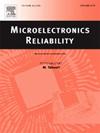基于多物理场耦合的 2.5D 封装工艺有限元分析,用于预测集成电路元件的可靠性
IF 1.6
4区 工程技术
Q3 ENGINEERING, ELECTRICAL & ELECTRONIC
引用次数: 0
摘要
2.5D 封装技术是一种高性能的电子封装方法。本研究探讨了 2.5D 封装在制造过程中的可靠性问题。研究人员开发了一种多物理场耦合有限元法(FEM),并结合子建模技术,以研究 2.5D 封装实体在各种制造过程中的底部填充粘合剂固化、环氧树脂模塑料固化以及中间件与基板之间的回流焊接。重点是封装结构中粘弹性成分的热机械化学行为,以及微焊球和微凸点的粘弹性特征。对 2.5D 封装在关键时间点的翘曲变形和应力分布进行了系统分析。结果表明,固化后,封装的整体翘曲呈现出 "凹 "形翘曲曲线。此外,随着芯片上方 EMC 厚度的增加,封装的翘曲值也会增加。线性弹性定义的翘曲值大于粘弹性定义的翘曲值。子模型关键区域的最大 Von Mises 应力值大于全局模型相应关键区域的最大 Von Mises 应力值。回流焊接后,微焊球的应力集中发生在微焊球阵列的边缘。包装中每个元件的最大应力值都出现在元件之间的界面区域。经历固化过程的封装元件的翘曲和 Von Mises 应力值明显高于未经历固化过程的元件。本研究建立的模拟方法可以准确预测 2.5D 包装的翘曲变形和应力分布状态,为 2.5D 包装在生产过程中的工艺优化和可靠性提升提供了重要的工程应用价值。本文章由计算机程序翻译,如有差异,请以英文原文为准。
Finite element analysis of 2.5D packaging processes based on multi-physics field coupling for predicting the reliability of IC components
The 2.5D packaging technology is a high–performance method for electronic packaging. This study addresses the reliability issues of 2.5D packaging during the manufacturing process. A multi–physics field coupling Finite Element Method (FEM) has been developed, combined with sub–modeling techniques, to investigate the curing of underfill adhesive, the curing of Epoxy Molding Compound (EMC), and the reflow soldering between the interposer and substrate in a 2.5D packaging entity during various manufacturing procedures. The focus is on the thermo–mechanical–chemical behavior of viscoelastic components within the packaging structure, as well as the viscoplastic characteristics of the micro solder balls and microbumps. A systematic analysis is conducted on the warpage deformation and stress distribution of the 2.5D packaging at crucial time points. The results demonstrate that after curing, the overall warpage of the packaging exhibits a ‘concave’ warpage profile. Additionally, as the thickness of the EMC above the chip increases, the warpage value of the packaging also increases. The warpage value defined by linear elasticity is larger than that defined by viscoelasticity. The maximum Von Mises stress value in the key areas of the submodel is greater than the maximum Von Mises stress value in the corresponding key areas of the global model. After reflow soldering, the stress concentration in the micro solder balls occurs at the edge of the micro solder ball array. The maximum stress values for each component of the packaging are observed in the interface areas between the components. Packaging components that undergo the curing process have notably higher warpage and Von Mises stress values than those that do not undergo the curing process. The simulation method established in this study can accurately predict the warpage deformation and stress distribution state of 2.5D packaging, providing significant engineering application value for process optimization and reliability enhancement of 2.5D packaging in the production process.
求助全文
通过发布文献求助,成功后即可免费获取论文全文。
去求助
来源期刊

Microelectronics Reliability
工程技术-工程:电子与电气
CiteScore
3.30
自引率
12.50%
发文量
342
审稿时长
68 days
期刊介绍:
Microelectronics Reliability, is dedicated to disseminating the latest research results and related information on the reliability of microelectronic devices, circuits and systems, from materials, process and manufacturing, to design, testing and operation. The coverage of the journal includes the following topics: measurement, understanding and analysis; evaluation and prediction; modelling and simulation; methodologies and mitigation. Papers which combine reliability with other important areas of microelectronics engineering, such as design, fabrication, integration, testing, and field operation will also be welcome, and practical papers reporting case studies in the field and specific application domains are particularly encouraged.
Most accepted papers will be published as Research Papers, describing significant advances and completed work. Papers reviewing important developing topics of general interest may be accepted for publication as Review Papers. Urgent communications of a more preliminary nature and short reports on completed practical work of current interest may be considered for publication as Research Notes. All contributions are subject to peer review by leading experts in the field.
 求助内容:
求助内容: 应助结果提醒方式:
应助结果提醒方式:


